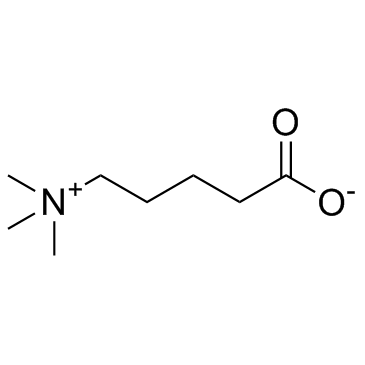delta-Valerobetaine |
| Catalog No.GC33459 |
Delta-Valerobetaine is a precursor of trimethylamine N-oxide (TMAO).
Products are for research use only. Not for human use. We do not sell to patients.

Cas No.: 6778-33-2
Sample solution is provided at 25 µL, 10mM.
Delta-Valerobetaine is a precursor of trimethylamine N-oxide (TMAO) [1]. Delta-Valerobetaine, microbiome-derived metabolite, is a diet-dependent obesogen that is increased with phenotypic obesity and is correlated with visceral adipose tissue mass in humans[2].
Delta-Valerobetaine is absent in germ-free mice and their mitochondria but present in ex-germ-free conventionalized mice and their mitochondria. Mechanistic studies in vivo and in vitro show Delta-Valerobetaine is produced by diverse bacterial species and inhibits mitochondrial fatty acid oxidation through decreasing cellular carnitine and mitochondrial long-chain acyl-coenzyme As. delta-Valerobetaine administration to germ-free and conventional mice increases visceral fat mass and exacerbates hepatic steatosis with a western diet but not control diet. Delta-Valerobetaine provides a molecular target to understand and potentially manage microbiome-host symbiosis or dysbiosis in diet-dependent obesity. Delta-Valerobetaine is produced in the rumen from free TML that occurs ubiquitously in vegetable kingdom [3].
Delta-Valerobetaine appears to be degraded by gut microbiota, as it happens for γ-butyrobetaine. In the biochemical pathways for the production and metabolism of TMA and TMAO, compounds containing the trimethylammonium group, such as betaines, choline, carnitine, are metabolized by gut microbiota producing TMA which is absorbed and travels via the portal circulation to the liver, where it is oxidized by flavin monooxygenases (FMO1 and FMO3) to TMAO, a metabolite known to positively correlate to the occurrence of cardiovascular risks[4-7].
References:
[1]. Servillo L, et al. Ruminant meat and milk contain δ-valerobetaine, another precursor of trimethylamine N-oxide (TMAO) like γ-butyrobetaine. Food Chem. 2018 Sep 15;260:193-199
[2]. Liu K H, Owens J A, Saeedi B, et al. Microbial metabolite delta-valerobetaine is a diet-dependent obesogen[J]. Nature Metabolism, 2021, 3(12): 1694-1705.
[3]. Servillo L, Giovane A, Cautela D, et al. Where does Nε-trimethyllysine for the carnitine biosynthesis in mammals come from?[J]. PloS one, 2014, 9(1): e84589.
[4]. Wang Z, Klipfell E, Bennett B J, et al. Gut flora metabolism of phosphatidylcholine promotes cardiovascular disease[J]. Nature, 2011, 472(7341): 57-63.
[5].Zeisel S H, Warrier M. Trimethylamine N-oxide, the microbiome, and heart and kidney disease[J]. Annual review of nutrition, 2017, 37: 157-181.
[6]. Randrianarisoa E, Lehn-Stefan A, Wang X, et al. Relationship of serum trimethylamine N-oxide (TMAO) levels with early atherosclerosis in humans[J]. Scientific reports, 2016, 6(1): 1-9.
[7]. Subramaniam S, Fletcher C. Trimethylamine N©\oxide: breathe new life[J]. British Journal of Pharmacology, 2018, 175(8): 1344-1353.
Average Rating: 5 (Based on Reviews and 11 reference(s) in Google Scholar.)
GLPBIO products are for RESEARCH USE ONLY. Please make sure your review or question is research based.
Required fields are marked with *




















